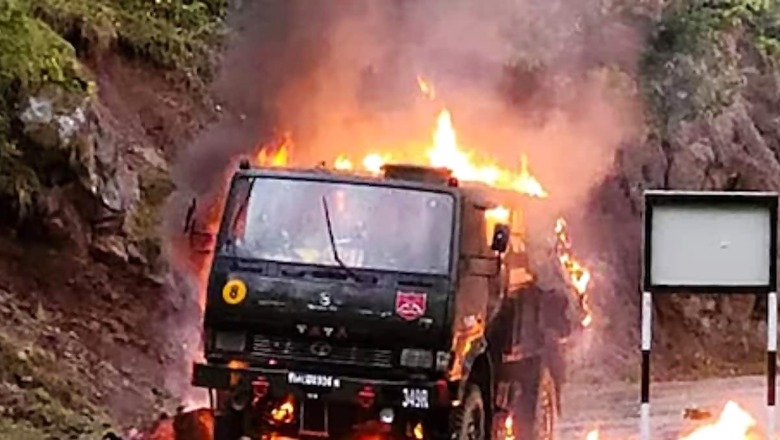
views
On April 20, 2023, five Indian Army bravehearts from the Rashtriya Rifles (RR) Unit, onboard a military truck, were killed in an ambush, reportedly laid by at least seven Pakistani terrorists, presumably including the OGW (Overground Worker/s), while approaching a crossroad at Tota Gali area en route to Poonch after crossing Bhimber Gali along the National Highway 144A. The only survivor is in a critical state and undergoing medical treatment at Army Hospital.
The bravehearts that were killed in action are Havildar Mandeep Singh, Lance Naik Debashish Baswal, Lance Naik Kuldeep Singh, Sepoy Harkrishan Singh, and Sepoy Sewak Singh.
Enemy’s Ambush and Ammunitions Used
It was a rainy day in Poonch with low visibility on April 20, 2023, when the six Indian Army jawans, including the driver, were carrying various necessary materials from the Rashtriya Rifles Headquarters in the Basooni area of Balakote, meant for distribution among the residents of Sangiote Village for the 7 PM Iftar celebration event, entirely organised by the RR Unit, where a crowd of 4000 from the village would have gathered to mark the celebrations.
The truck, with its wipers on all the way, reportedly moved carefully at a slow speed on its way from Bhimber Gali, where the RR Unit has a significant presence owing to the movement of the Indian Army convoys between Poonch and Rajouri, and picked up more items as it moved along the NH 144A that covers Akhnoor, Sunderbani, Nowshera and Rajouri between Jammu and Poonch.
The point of pertinence and concern is that NH 144A is located extremely close to the city of Rawalpindi in Pakistan, which hosts the General Headquarters (GHQ) of the Pakistan Army. The distance between Bahawalpore, the HQ of the Jaish-e-Mohammed (JeM) terror outfit and Rawalpindi is close to seven and a half hours by road. Travel time can significantly be decreased when dedicated helicopters are flown with their transponders off through the enemy’s Delta class air space using Visual Flight Rules (VFR) to ferry the plain cloth-wearing paid mercenaries from places like Bahawalpore or Muridke or Ghazi Base in Attock, Punjab to ferry the SSG, a.k.a core of the Border Action Teams (BAT). The Special Service Group (SSG) of the Pakistan Army, trained to deal with special operations, counter-terrorism, unconventional warfare, foreign internal defence, special reconnaissance and direct action, is the core of the BAT, a joint venture of the Pakistan Army and the terrorists deployed for India-centric attacks along the Line of Control (LoC).
The distance between SSG HQ, located at the Ghazi Base is close to just two hours by road and considering that it has an airbase too, it would again be a matter of minutes to gather the SSG/BAT at the GHQ Rawalpindi along with the ISI officials for planning, reconnaissance missions and finally, the implementation of the beyond barbaric attacks.
Relevant
- Geo-Strategic Importance of Poonch and Rajouri Districts in Jammu Division, located at the South and East of Pir Panjal
“Rajouri and Poonch have remained preferred routes for infiltration as they get less snow and the terrain is easier than Kashmir. People in this region are overwhelmingly nationalist and against terrorism but Hurriyat and Jamaat-e-Islami (JeI) have tried to radicalise them in the past,” stated former DGP of the Jammu and Kashmir Police, SP Vaid, in an interaction with the media in 2021, when at least nine Indian Army bravehearts were killed by separate ambushes in the same terrain in the month of October and the massive retaliatory buildup by the Indian Army that included the Para Special Forces yielded practically no results even after three weeks of combing and search operations.
It also has reportedly been mentioned by concerned authorities, on the condition of anonymity, that “Sangiot and Balakote in Mendhar is an infiltration route. Once in, the terrorists cross Bhimber Gali and enter Nar Khas and Bhata Dhuriyan forests from where they can go to Thannamandi or Bufliaz to Pir Ki Gali and head towards Shopian.” It is my suspicion as a National Safety, Security, Aviation and Avionics Analyst that the multiple ambushes faced by the Indian Army along these areas in recent times and the past have been executed by highly trained uniformed personnel of the enemy, resulting in recurring and beyond barbaric fatalities on the Indian side that went mostly non-avenged purely owing to the enemy’s extremely well-executed utilisation of the dense forests, an area which they certainly have worked on for many years.
- The G20 Meeting to be attended by the world leader, scheduled to take place in Leh from 26 to 28 April, 2023 and Srinagar from 22 to 24 May, 2023
Needless to state, it has sent severe shockwaves both in China and Pakistan. While China, with its most surreal and daring footfall, built infrastructure inside PoK, which is justifiably India’s integral part after Pakistan’s brazen violation of aeons of UNSC directive to vacate its illegally occupied part of Kashmir via UNSC Resolution No. 47/1948, in which Pakistan sent tribesmen and Pakistani nationals were prominently identified and documented by the UN Security Council in Page 4 of the Resolution under “restoration of peace and order (a)” as non-residents (raiders) that entered Kashmir for the purpose of fighting. The question of a plebiscite does not arise as it has become meaningless and obsolete with the passage of time and Pakistan’s complete violation of the UNSC directives for aeons. Thus, both China and Pakistan’s misadventures are facing the inevitable danger in the forms of irreplaceable loss of illegal investment and territorial occupation respectively.
The last nail on the coffin has also been most firmly and precisely fixed by India for China and Pakistan respectively with the G20 meeting in Leh post the Galwan clash and ongoing China-India standoff along the Line of Actual Control (LAC) and in Srinagar post the abrogation of Article 370.
The ambush pattern and the name of the terrorist group that claimed the attack (PAFF) has a lot of similarities with the Chinese People’s Liberation Army (PLA) supported People’s Liberation Army of Manipur (PLA-M) and other VBIGs (Valley Based Insurgent Groups) along the densely forested India-Myanmar border. This Blitzkrieg is, in my opinion, a joint venture of China and Pakistan against India.
The enemy’s plan of action is a revalidation that the terrorists certainly had pre-planned the ambush. They, in all practicalities, have done prior recce of the area and could have been also accompanied by one or more messengers that passed on information about the approaching truck to the terrorist hiding in the forests. In my opinion, encrypted and continuous communication through easily available transceiver sets at online marketplaces is a high possibility. Such sophisticated transceivers could also have been provided by the Pakistani Army/SSG to its units in disguise operating in the area.
For, waiving or any other mode of body movements would have carried the risk of getting the attention of other plying vehicle drivers/passengers, besides communication between different points of the open highway and between the open highway and the dense forest, where the mercenaries were hiding, couldn’t have been realistically possible without the encrypted wireless communications. The terrorists reportedly shot the front of the truck first, using a sniper rifle, and subsequently surrounded the truck probably from all sides and mercilessly fired on the soldiers in the truck. The armour-piercing ‘7.62 mm’ steel bullets reportedly had a marking that read ’71’, a validation that these were manufactured in ammunition factories inside China. They reportedly fired RPG (Rocket-Propelled Grenade), a shoulder-fired missile weapon. It launches rockets with explosive warheads and can be carried and operated by a well-trained individual. The attackers also used sticky bombs and fled with the arms and ammunition of our helpless soldiers under a heavy and extremely well-executed attack.
Another point that I would like to bring to the notice of all the concerned authorities in Military Intelligence and other appropriate agencies of ours is the knowledge of the attackers and their informers on the distance maintained between the other vehicles in both directions of NH 144A, whether civilian or military and their targeted Indian Army truck. We must remind ourselves once again that the area roars with the frequent Army convoys, primarily belonging to the Rashtriya Rifles Unit, between Poonch and Rajouri in the Jammu division. In such a situation, the terrorists or the highly trained uniformed personnel of the enemy had to be precisely aware of the place and time to hit its target in an isolated zone with sufficient time, so that no vehicle, whether civilian or military, would be able to spot their barbaric operations from a safe distance, which would certainly have jeopardised their execution and escape as extremely skilled RR units equipped with the most advanced weaponry to its teeth would have rushed from Bhimber Gali to Tota Gali in a matter of minutes, and not only blood bathed the cowardly perpetrators but also would have waged war against the enemy after gaining knowledge on enemy’s probable camouflaged hideouts within the dense forests. That intriguing factor topped by the swiftness of not only the total operation but also their smooth and professional running away from the spot with the extra and presumably heavy loads of stolen arms and ammunition only points out that it was not an ordinary terrorist attack by any stretch of imagination, but a well-collaborated and coordinated Blitzkrieg, conducted by highly trained uniformed personnel of our unchangeable enemies.
Conclusion
Bhata Dhuriyan forest area remains a notorious infiltration route for terrorists attempting to sneak into India by crossing the LoC due to its topography, dense forest cover and natural caves as per the people having adequate knowledge. The highly trained enemy professionals, I suspect, have built an undetectable, impenetrable mechanism and infrastructure deep within the dense forests for a smooth crossover or stationed themselves for long hauls with enough food and other essential materials to sustain and are equipped with state-of-the-art navigational, communication equipment and most sophisticated armaments.
We need to take control of the batton to change the music that China- Pakistan orchestra are currently playing and at the same time, we need to be the ringmaster to keep both reined in. For this to happen, we have to be extraordinarily aggressive in changing the topographic dominance in Poonch and Rajouri districts under the Jammu division.
A random and/or stray surgical strike this time will just be a waste of time, energy and money which will not only help the cash-starved enemy across the LoC and the IB in deviating the attention of its angry citizenry but also influence the global opinion. It has to be a pushing of the Western borders and reunion of Pakistan-Occupied Kashmir (PoK) with no IFs and BUTs to checkmate the enemy. Use of Indian Air Power will have to be utilised in full capacity while calculating the smaller enemy’s maximum strength. Indian Army’s infantry and special forces have to be prepared to be all over the Pakistani hinterlands in a highly systematic manner, especially in the regions where the terror infrastructures exist. For example, Bahawalpore and Muridke, the bases for JeM and LeT, respectively.
Pakistan’s SSG HQ and training centre will have to be razed alongside the LeT, JeM headquarters and all the launch pads plus the human assets. Indian Navy has to block and bomb the waterways of Pakistan and needs to inflict massive damage to Pakistan’s naval capabilities. GHQ Rawalpindi, all military establishments including the residential addresses of Pakistani Army Generals, the ISI HQ and its organisational head must bear the brunt.
The Poonch Attack of April 20, 2023, will have to be retaliated in an unprecedented and befitting manner that should not only be unpredictable for the enemy but should also leave them in a helpless state as they did with our head held high heroes and have been doing since aeons. We also have to be doubly swift, agile and silent in our planning, preparations and highly precise executions. Collateral damage prevention should no more be a priority for our forces. This time around, India’s scale and dimension of retaliation has to be very different from the past. The unavoidable, imminent and widespread retaliatory actions of the Poonch attack are going to be not only a test of the mettle of the glorious Indian tri forces, but also a test of resolve for the people of the Indian Republic, across all religious beliefs, caste and creed.
Arya Ghosh is a National Safety, Security, Aviation and Avionics Analyst. The views expressed in this article are those of the author and do not represent the stand of this publication.
Read all the Latest Opinions here



















Comments
0 comment